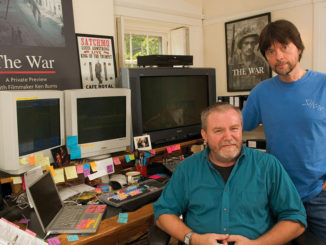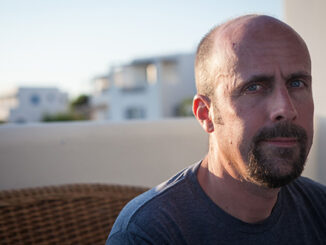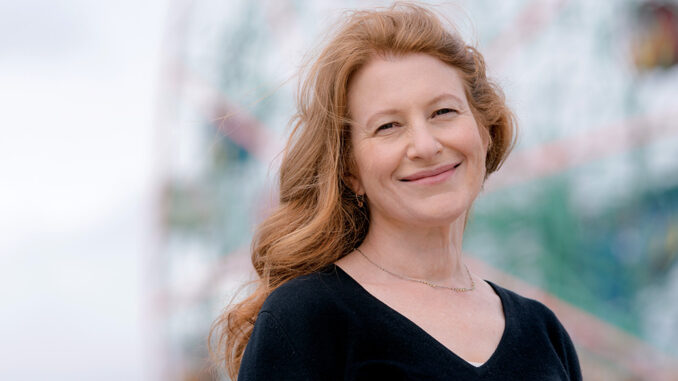
by Peter Tonguette • portraits by Sarah Shatz
Over the past two decades, editor Alisa Lepselter, ACE, has worked on a range of films. Her credits include a caper set in the cookie business, a farce focused on a filmmaker afflicted with blindness, and a crime story populated by England’s upper classes.
Despite their outward variety, the films share the same inimitable writer, director and periodic leading man: Woody Allen. Since 1998, when the New Jersey native was hired to edit Sweet and Lowdown, released the following year, Lepselter has served as Allen’s sole editor, collaborating with the filmmaker on 20 projects: 19 features, including the already-referenced Small Time Crooks (2000), Hollywood Ending (2002) and Match Point (2005), as well as his latest, Wonder Wheel (which opened December 1 through Amazon Studios), plus one six-part online series, Crisis in Six Scenes (2016). And she is currently at work on Allen’s planned 2018 release, A Rainy Day in New York.
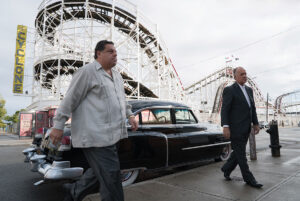
Although forever linked with New York-set comedies with high-strung, hypochondria-inclined characters, Allen is in fact an eclectic filmmaker, and never more so than during his years working with Lepselter.
“It’s great that we mix it up between comedies and dramas,” Lepselter tells CineMontage. “It makes it more interesting, but the process doesn’t change that much. Obviously, you’re hoping that your comedies are funny and your dramas are not. But certainly there have been times when I’ve worked on a drama, and I’ve seen it with an audience for the first time — and they’re laughing at things that never seemed funny to me. I think people are predisposed to laugh when they go to see a Woody Allen movie.”
Yet some of the finest Allen films have both induced laughs and encouraged contemplation, including her favorite film of the director’s, Crimes and Misdemeanors (1989), in which the story of a love affair that leads to murder unfolds alongside the tale of a woebegone documentarian. Curiously, that film, which garnered Allen his fifth Oscar nomination in the Best Director category, was not edited by Lepselter, but by her predecessor, Susan E. Morse, ACE (see related story on Woody Allen’s editors, page 78).
“Crimes and Misdemeanors was before my era, but it’s so brilliant in the way that it’s such an incredibly compelling drama with such amazing humor woven into it so beautifully,” she explains.
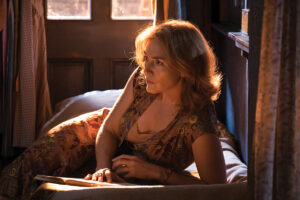
The new Wonder Wheel might be said to have the same magic mixture of drama and comedy, although it favors the former. The mid-century-set film concerns the strained relationship between Coney Island carousel operator Humpty (Jim Belushi) and his second wife, Ginny (Kate Winslet). Not unlike young Alvy Singer in Annie Hall (1977), whose boyhood home was situated beneath a rollercoaster, Humpty and Ginny live in an apartment in the middle of the amusements on the boardwalk. “The Wonder Wheel is the famous, iconic Ferris wheel in Coney Island, so it looms in the background everywhere,” Lepselter clarifies. “You can see it right from their window.”
Into Humpty and Ginny’s unhappy union saunters Carolina (Juno Temple), the product of Humpty’s first marriage, who is drawn to reconnect with her father following a relationship with a gangster. The less-than-euphoric family reunion is observed from the perspective of a lifeguard (and would-be writer) played by Justin Timberlake, who also supplies occasional narration.
“I’m really proud of this film,” Lepselter comments. “It takes place in the early 1950s, and it does feel like a melodrama from that era. I wouldn’t say it’s a feel-good movie, but it was a lot of fun to work on.”
Many Allen films begin production during the summer, with post-production commencing in the fall, but Wonder Wheel’s schedule was delayed until after summer to accommodate location shooting on Coney Island. “To have permission to shoot on the Coney Island boardwalks, we had to wait until after Labor Day,” Lepselter says. “So we filmed in September and October.” Like his first film with Allen, last year’s Café Society, cinematographer Vittorio Storaro, ASC, AIC, shot Wonder Wheel digitally, bringing to an end — at least for the time being — Allen and Lepselter’s longstanding routine of screening dailies.
“We don’t screen dailies together anymore,” the editor explains. “He’s looking at everything on a monitor on the set with Vittorio. When he used to shoot on film, at the end of the day for years and years, my assistants would sync dailies on film, and then we’d have a screening, but that hasn’t happened in several years.”
But, according to Lepselter, Allen is amenable to working in whichever medium is preferred by his cinematographer on a given project. “If he has a cinematographer like Darius Khondji, who really wants to work in film and thinks that’s what will best serve the particular movie, then Woody would be open to that,” Lepselter says, referring to the DP who shot five Allen films, including Anything Else (2003) and To Rome with Love (2012). “Vittorio has his reasons for wanting to shoot digitally, and Woody was open to that as well.”
The results are a sight to behold: Far from the muted color scheme that characterizes earlier Allen films such as Annie Hall or Hannah and Her Sisters (1986), Wonder Wheel boasts a visual style that calls to mind a brightly lit Christmas tree, from the dazzling Coney Island attractions to the rich, colorful lights that bathe the bedroom of Humpty and Ginny. “There is something really magical about what Vittorio has done with the light and the color,” Lepselter offers. “It’s so different from so many of the films that Woody has made in the past.”
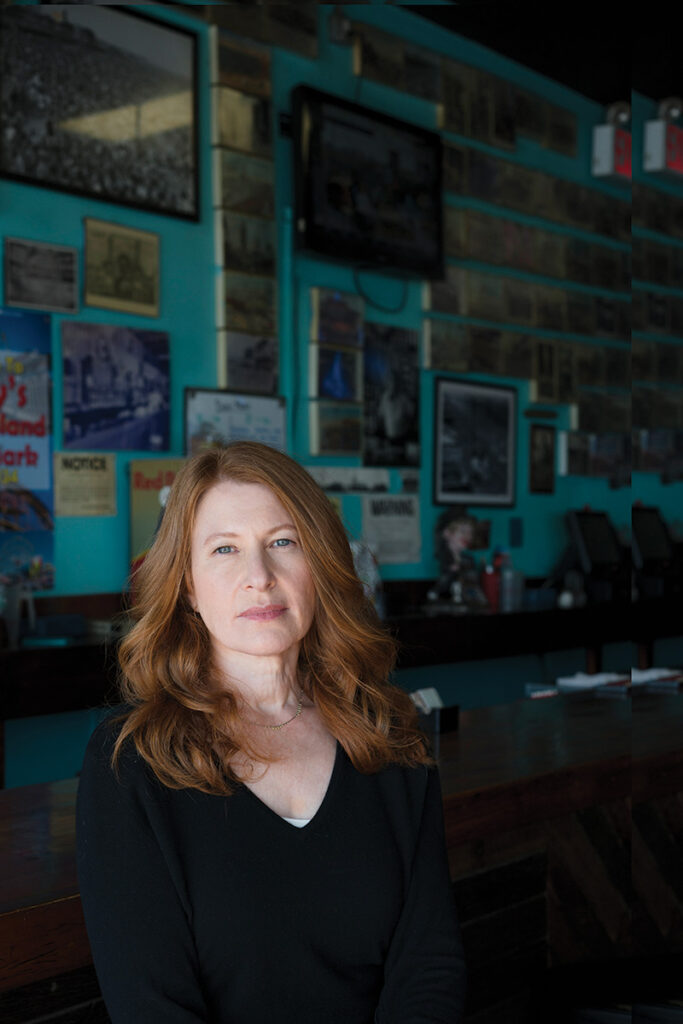
The film’s singularly striking palette notwithstanding, the editor’s working methods on Wonder Wheel did not deviate from those established long ago on her films with Allen. Although she no longer screens dailies with him, she views and takes notes on footage as it’s coming in. “If he has anything that he needs to talk to me about, or wants to look at, we certainly would do that,” Lepselter says. “But generally, the day after he’s done shooting, he comes to the cutting room, and we start cutting from the very beginning.”
In an office located inside a residential building in New York — containing both an editing room and screening room — Lepselter cuts on an Avid while Allen often looks on. Like all of their collaborations, Wonder Wheel was cut in sequence. “I feel spoiled that I get to do that,” she concedes. “The consistency of working from Scene 1 through the end of the film has been very helpful. You are maintaining a sense of the tone of the film from the beginning.”
It is not unusual for a film to be in assembly form before major changes are made, but other times, problem scenes are dealt with in the course of Lepselter’s initial pass at the material. “Sometimes, we’ll be in the middle of the assembly, and we’ll realize something isn’t working so we’ll eliminate it even before it’s made the first cut,” she explains. “We cut it together and, if there’s something that’s going to take me any amount of time to figure out — like because it’s technically challenging — he might go in the other room or go home for lunch.”
The film is continually honed and refined during the assembly process, so Lepselter’s initial cuts are frequently not significantly longer than her final cuts. In the case of Wonder Wheel, she estimates that the first cut was only about 10 minutes longer than its ultimate length of 101 minutes. “There have been films where we’ve cut out a lot more material than that,” the editor reveals. “This was a pretty tight script. There have been times when we’ve wanted to lose a scene and we felt that we couldn’t because we really didn’t have any extra to lose as far as telling the story. He’s famous for not shooting a lot of material that he doesn’t need, and after some 50 films, he knows what he needs.”
Allen is equally famous for his proclivity to allow whole scenes to unfold in extended master shots. “Woody doesn’t like cutty films,” Lepselter confirms. “He finds that it distracts him if there’s over-the-shoulder, close-up, back-and-forth. It’s not his style.” However, when the editor viewed dailies for her inaugural film with Allen, Sweet and Lowdown, she encountered more coverage than she expected — or would find in many subsequent films. “I knew from having been a Woody Allen fan my whole life that he shot a lot of scenes in one take,” she says. “I started watching the dailies and there was an enormous amount of coverage. I was surprised and stunned. He said, ‘You know, this is an old-fashioned film. I wanted it to have an old-fashioned feeling, and I wanted to shoot it more traditionally.’”
Allen’s long-take tendency, however, is in full force in Wonder Wheel. During a scene in which Carolina arrives on the boardwalk, the camera glides with her as she walks past the spinning rides, pausing on a sign that reads: “CONEY ISLAND: BARREL OF LAFFS.” When Carolina enters Ruby’s Clam House, where Ginny whiles away her days as a waitress, the camera lingers on the characters during their first, tense introduction.
“Even for Woody, Wonder Wheel has some very long masters,” Lepselter observes. “There are some scenes that are very long takes, and the camera is sweeping around for an entire scene. And occasionally I’ll think, ‘I wish I had a cutaway.’ But you choose a take and that’s it.” That said, the editor attests that the long-take aesthetic worked perfectly for the theatricality of the film. “It was a choice that the director and the cinematographer felt worked for the setting,” she adds. “It really gave it an interesting feeling.”
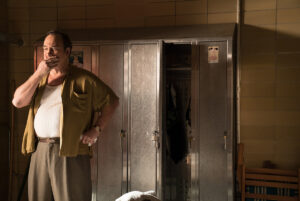
Consequently, editorial decisions often revolved around the elimination or shuffling of whole scenes rather than cutting within them. “There was a lot of discussion about a certain part of the film — whether or not we were jumping in tone in Kate’s performance in an unfortunate way,” Lepselter explains. “It has to do with her character’s development, her relationship to the other characters, and whether it felt like she got from Point A to Point B too quickly.” The solution was dropping a scene that was standing in the way. “It was causing us to experience a discordant feeling in that character’s development,” she reveals. “I suggested taking out a scene that had been a bridge, and when we lost the bridge, it actually made things more clear.”
As for the actors, Lepselter singles out the performance of Winslet, who makes her first appearance in an Allen film, although was originally set to appear in the Scarlett Johansson role in Match Point. “We all know she’s a wonderful actress, but she would give us so many choices,” the editor enthuses. “I’ve worked with a lot of wonderful performers who might do a lot of different takes, and then you know it’s the last one or it’s the first one that we’re going to use. But my challenge was that Kate gave us all these different choices and they were all great; they were just different directions to go in.”
Lepselter estimates that assemblies on Allen films usually come together within several weeks, with refinements taking an additional four to eight weeks. In the case of Wonder Wheel, the schedule was extended due to the inclusion of CGI — the first substantial use of such effects in a film by the director. After an almost-final cut was prepared, the visual effects house created Coney Island in the 1950s. “When the characters were outside and actually on the boardwalk, much of that was the real Coney Island boardwalk,” the editor explains. “But when they were in their apartment, and you’re looking out the window and seeing the view, that was all CGI. It was easier with the digital dailies than if we had shot on film.”
While Allen never takes his films out for previews, he does hold screenings to garner responses from what Lepselter calls “some very well-trusted people.” She adds, “We only ever show it to a very small, select group of people.”
In putting together a soundtrack, the director still draws from his record collection — and, in a reflection of changing times, online sources. “We still do often go to his collection of vinyl,” Lepselter says, but since this film was set in the 1950s — not Allen’s favorite musical period, according to his editor — she was tasked with researching songs of the era. “I would pull things up from searching online and sample many, many, many different songs from the era until we found ones that worked,” she says. “We would load any number of those into the Avid so that we could sample them against the picture.”
Lepselter has twice been nominated for ACE Eddie Awards in the category of Best Edited Feature Film — Comedy or Musical for Allen’s films: Vicky Cristina Barcelona (2008) and Midnight in Paris (2011). But, like her director, the editor places little importance on such recognition. “I did think that there was more visible editing in those films,” she says. “But frankly, working with Woody, who really puts no stock in awards, I have spent all these years not really paying attention to awards myself.” Regarding Wonder Wheel, she feels that the film features “so many long masters, that it’s not something I would ever imagine being nominated for an award for editing.”
Then again, you never know. After all, upon being hired to work on Sweet and Lowdown nearly 20 years ago, Lepselter did not necessarily expect the collaboration with Allen to last for more than that single film. “I had no idea that would happen,” she reflects. “It wasn’t apparent right away that it would become the next 20 years of my life.” After so many movies together, the two enjoy a unique cutting room partnership.
“I certainly have a real understanding of how he likes to work now,” Lepselter concludes. “And there’s a lot that doesn’t even have to be spoken between us at this point.”



